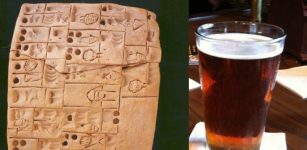Great Living Chola Temples: Outstanding Workmanship Of Chola Dynasty Builders Of South India
A. Sutherland - AncientPages.com -The Great Living Chola Temples were built by powerful kings of the Chola Empire, which stretched across southern India, and the neighboring islands.
 Airavatesvara Temple at Darasuram. Image credit: Gughanbose - CC BY-SA 3.0
Airavatesvara Temple at Darasuram. Image credit: Gughanbose - CC BY-SA 3.0
Three temples of the Chola: the Brihadisvara Temple at Gangaikondacholisvaram, the Airavatesvara Temple at Darasuram, and the Brihadisvara Temple at Thanjavur, are dated to the 11th and 12th centuries.
Brihadeeshwara Temple, of which foundations were laid by the Chola king Rajaraja I in 1002 AD, is probably the finest temple in Tamil Nadu.
Powerful Chola Dynasty
The Chola dynasty was one of the longest-ruling dynasties in the history of southern India. The earliest references to this Tamil dynasty are preserved inscriptions dated to the 3rd century BC left by Ashoka.
Ashoka, who died in 232 BC, was one of India's most extraordinary emperors, the Maurya Dynasty. He ruled most of the Indian subcontinent from about 268 to 232 BC.
 Airavatesvara Temple; Image credit: Gughanbose - CC BY-SA 3.0
Airavatesvara Temple; Image credit: Gughanbose - CC BY-SA 3.0
Ashoka reigned over a realm that stretched from the Hindu Kush mountains in Afghanistan to the modern state of Bangladesh in the east.
The great Chola rulers also had significant influence over modern-day southeast Asia. The magnificent Chola Temples testify to the remarkable achievements of the Chola architects, engineers, and artisans.
Significance And Beauty Of The Chola Temples
The Chola kings strongly emphasized the importance of temples, which were places of gatherings for political, economic, and cultural activities, and all-important official ceremonies were held there. The structures demonstrated the enormous power of the Chola rulers, their wealth, imperial domain, and religious importance in the cities.
The temples became a central place in the economy of medieval India, and society depended on them.
Thanjavur Brihadeeswara Temple view from the back. The two gopuras (temple entrance tower) can be seen in the back. Image credit: Aravindreddy.d - CC BY-SA 3.0
Supported by the grants and incoming cash from the kings, wealthy merchants, and nobles, the temples flourished. With time, they became consumers, moneylenders, and employers of priests, musicians, artisans, and people (both men and women) working in temple service.
Additionally, these temples were considered important centers of education and learning, where Sanskrit played a crucial role. The temples' other goal was to encourage and preserve art such as sculpting, painting, and dance, which flourished in the Chola temples.
Today, the temples still have impressive features such as Vimana (the central deity's shrine with a towering roof) and mandapa, a pillared pavilion adorned with elaborate carvings for public rituals.
The Great Living Chola Temples- This is the Brahadeshwara big temple tower. Credit: Adobe Stock - Aarthi
Another impressive feature in the Hindu temple is garbha (literally: 'womb chamber'), decorated with the idol of the temple's main deity.
This chamber is reserved only for priests. Yet another magnificent part of the temples are unique, powerful gopurams (towers), which date back to the early structures of the Tamil kings Cholas, Cheras, Pandyas, and Pallavas.
The Chola temples have all their massive superstructures, richly adorned with portraits, decorative sculptures, paintings, and icons. The temple, dedicated to Shiva, characterizes the tradition of Chola master builders, who indeed loved symmetrical geometry, which is visible in the planning of the temple.
Chola era art demanded dedicated and sophisticated artisans, and their legacy is still admired in India.
Written by – A. Sutherland AncientPages.com Staff Writer
Copyright © AncientPages.com All rights reserved. This material may not be published, broadcast, rewritten or redistributed in whole or part without the express written permission of AncientPages.com
Expand for referencesReferences:
Malarvannan, A. The Life of Mahabalipuram
Thapar, B. Introduction to Indian Architecture
More From Ancient Pages
-
 Oldest Evidence Of Beer Was Found On A Sumerian Tablet In Mesopotamia
Ancient History Facts | Jan 23, 2016
Oldest Evidence Of Beer Was Found On A Sumerian Tablet In Mesopotamia
Ancient History Facts | Jan 23, 2016 -
 ‘Viking Disease’ Hand Disorder May Come From Neanderthal Genes
Archaeology | Jun 14, 2023
‘Viking Disease’ Hand Disorder May Come From Neanderthal Genes
Archaeology | Jun 14, 2023 -
 Runic Inscription On The Viking-Age Galloway Hoard Deciphered
Archaeology | Feb 13, 2025
Runic Inscription On The Viking-Age Galloway Hoard Deciphered
Archaeology | Feb 13, 2025 -
 Mystery Of The Knights Templar – Did A Secret Ancient Meeting Determine The Real Purpose Of The Christian Knights? Part 1
Ancient Mysteries | Aug 20, 2019
Mystery Of The Knights Templar – Did A Secret Ancient Meeting Determine The Real Purpose Of The Christian Knights? Part 1
Ancient Mysteries | Aug 20, 2019 -
 Roman Copper-Alloy Tortoise Figurine Discovered In Suffolk, UK
Archaeology | Dec 4, 2023
Roman Copper-Alloy Tortoise Figurine Discovered In Suffolk, UK
Archaeology | Dec 4, 2023 -
 New Study: Middle Neolithic Circular Enclosure Of Goseck – Sacred Place And Astronomical Observatory
Archaeology | Aug 9, 2023
New Study: Middle Neolithic Circular Enclosure Of Goseck – Sacred Place And Astronomical Observatory
Archaeology | Aug 9, 2023 -
 Earliest Evidence Of A 260-Day Maya Calendar Found Inside Guatemalan Pyramid
Archaeology | Apr 14, 2022
Earliest Evidence Of A 260-Day Maya Calendar Found Inside Guatemalan Pyramid
Archaeology | Apr 14, 2022 -
 Dead City Of Serjilla – Byzantine Village In Syria Struggling To Survive The Middle Of A War Zone
Featured Stories | Jan 27, 2020
Dead City Of Serjilla – Byzantine Village In Syria Struggling To Survive The Middle Of A War Zone
Featured Stories | Jan 27, 2020 -
 Gefjon: Norse Fertility Goddess Who Knew Humans’ Fates, And Plowed Away Part Of Sweden To Give It To Denmark
Featured Stories | Nov 22, 2019
Gefjon: Norse Fertility Goddess Who Knew Humans’ Fates, And Plowed Away Part Of Sweden To Give It To Denmark
Featured Stories | Nov 22, 2019 -
 Tahpanhes – Biblical City Where Prophet Jeremiah And King Zedekiah’s Daughters Hid From The Babylonians
Biblical Mysteries | Jul 19, 2021
Tahpanhes – Biblical City Where Prophet Jeremiah And King Zedekiah’s Daughters Hid From The Babylonians
Biblical Mysteries | Jul 19, 2021 -
 Deir el-Bahri – Sacred Resting Place For The Pharaohs
Featured Stories | Mar 22, 2022
Deir el-Bahri – Sacred Resting Place For The Pharaohs
Featured Stories | Mar 22, 2022 -
 America’s Ancient “Mystery Stone” Remains An Unexplained Puzzle
Artifacts | Apr 17, 2014
America’s Ancient “Mystery Stone” Remains An Unexplained Puzzle
Artifacts | Apr 17, 2014 -
 Amakuni – Legendary Japanese Blacksmith And Father Of The Samurai Sword
Featured Stories | Jan 23, 2019
Amakuni – Legendary Japanese Blacksmith And Father Of The Samurai Sword
Featured Stories | Jan 23, 2019 -
 Kava – Astonishing Ancient Plant That Improves Emotional Intelligence Is Gaining Popularity In The Western World
Featured Stories | Mar 31, 2018
Kava – Astonishing Ancient Plant That Improves Emotional Intelligence Is Gaining Popularity In The Western World
Featured Stories | Mar 31, 2018 -
 Mysterious Books With Dangerous Secret Knowledge Deliberately Hidden From Public View
Featured Stories | Jan 8, 2024
Mysterious Books With Dangerous Secret Knowledge Deliberately Hidden From Public View
Featured Stories | Jan 8, 2024 -
 Elusive Non-Binary Gender In Prehistoric Europe – A Forgotten Minority
Archaeology | May 26, 2023
Elusive Non-Binary Gender In Prehistoric Europe – A Forgotten Minority
Archaeology | May 26, 2023 -
 Clues To The Mysterious Dog-Headed St. Christopher And His Connection To The Egyptian Jackal God Anubis Found?
Featured Stories | Jan 14, 2025
Clues To The Mysterious Dog-Headed St. Christopher And His Connection To The Egyptian Jackal God Anubis Found?
Featured Stories | Jan 14, 2025 -
 Magnificent Alsengem Among 30,000 Archaeological Objects Discovered In Kalmar, Sweden
Artifacts | Mar 5, 2024
Magnificent Alsengem Among 30,000 Archaeological Objects Discovered In Kalmar, Sweden
Artifacts | Mar 5, 2024 -
 The Magnificent Ancient ‘Flying Airship’ Of King Solomon
Featured Stories | Aug 27, 2018
The Magnificent Ancient ‘Flying Airship’ Of King Solomon
Featured Stories | Aug 27, 2018 -
 Amazing Ancient Chumash Cave Paintings In California Offer Insight Into Ancient Shamanism And Supernatural Beliefs
Civilizations | Nov 5, 2018
Amazing Ancient Chumash Cave Paintings In California Offer Insight Into Ancient Shamanism And Supernatural Beliefs
Civilizations | Nov 5, 2018


